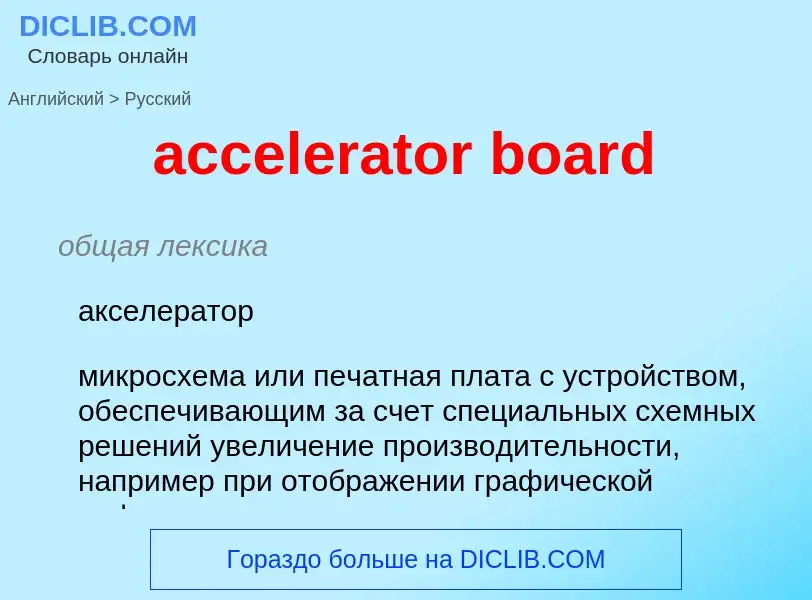Vertaling en analyse van woorden door kunstmatige intelligentie ChatGPT
Op deze pagina kunt u een gedetailleerde analyse krijgen van een woord of zin, geproduceerd met behulp van de beste kunstmatige intelligentietechnologie tot nu toe:
- hoe het woord wordt gebruikt
- gebruiksfrequentie
- het wordt vaker gebruikt in mondelinge of schriftelijke toespraken
- opties voor woordvertaling
- Gebruiksvoorbeelden (meerdere zinnen met vertaling)
- etymologie
accelerator board - vertaling naar russisch
общая лексика
акселератор
микросхема или печатная плата с устройством, обеспечивающим за счет специальных схемных решений увеличение производительности, например при отображении графической информации
Смотрите также
общая лексика
аппаратный ускоритель, акселератор
устройство, выполняющее некоторый ограниченный набор функций для повышения производительности всей системы или отдельной её подсистемы
Смотрите также
общая лексика
аппаратное ускорение
работы с графикой
Definitie
Wikipedia

Hardware acceleration is the use of computer hardware designed to perform specific functions more efficiently when compared to software running on a general-purpose central processing unit (CPU). Any transformation of data that can be calculated in software running on a generic CPU can also be calculated in custom-made hardware, or in some mix of both.
To perform computing tasks more quickly (or better in some other way), generally one can invest time and money in improving the software, improving the hardware, or both. There are various approaches with advantages and disadvantages in terms of decreased latency, increased throughput and reduced energy consumption. Typical advantages of focusing on software may include more rapid development, lower non-recurring engineering costs, heightened portability, and ease of updating features or patching bugs, at the cost of overhead to compute general operations. Advantages of focusing on hardware may include speedup, reduced power consumption, lower latency, increased parallelism and bandwidth, and better utilization of area and functional components available on an integrated circuit; at the cost of lower ability to update designs once etched onto silicon and higher costs of functional verification, and times to market. In the hierarchy of digital computing systems ranging from general-purpose processors to fully customized hardware, there is a tradeoff between flexibility and efficiency, with efficiency increasing by orders of magnitude when any given application is implemented higher up that hierarchy. This hierarchy includes general-purpose processors such as CPUs, more specialized processors such as GPUs, fixed-function implemented on field-programmable gate arrays (FPGAs), and fixed-function implemented on application-specific integrated circuits (ASICs).
Hardware acceleration is advantageous for performance, and practical when the functions are fixed so updates are not as needed as in software solutions. With the advent of reprogrammable logic devices such as FPGAs, the restriction of hardware acceleration to fully fixed algorithms has eased since 2010, allowing hardware acceleration to be applied to problem domains requiring modification to algorithms and processing control flow. The disadvantage however, is that in many open source projects, it requires proprietary libraries that not all vendors are keen to distribute or expose, making it difficult to integrate in such projects.


